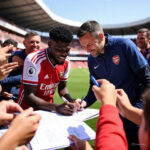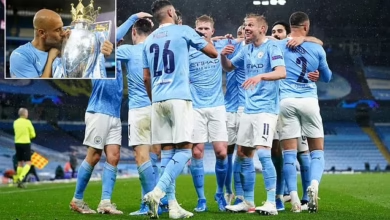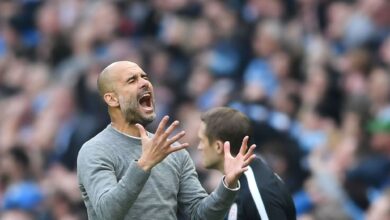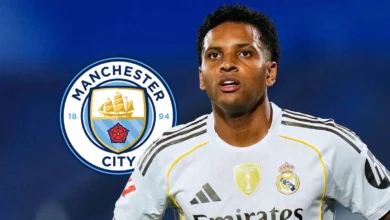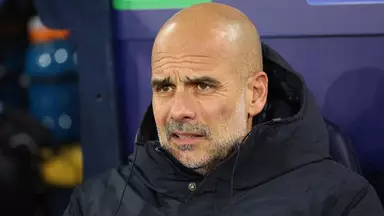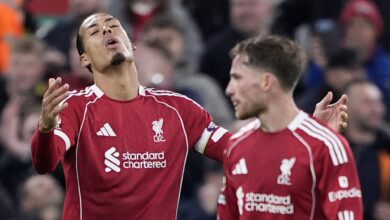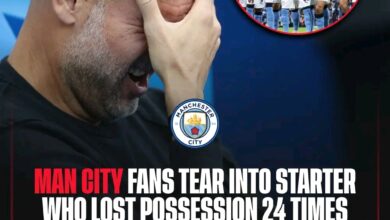Thomas Partey’s Arsenal Departure: A New Chapter Begins
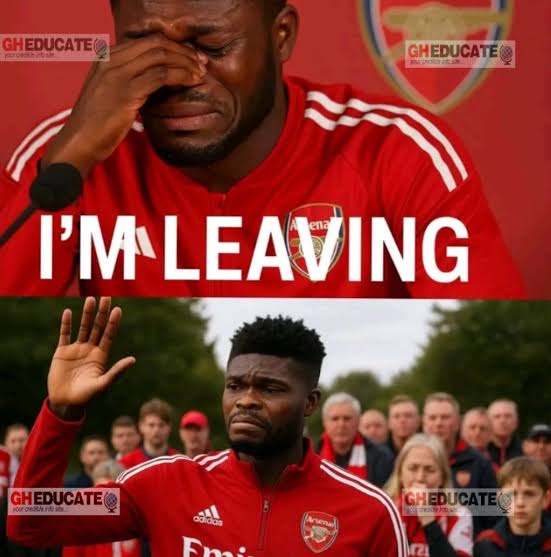
Thomas Partey’s journey at Arsenal has officially come to an end, marking the conclusion of what can only be described as a complex and often frustrating chapter for both player and club. The 31-year-old Ghanaian midfielder has become a free agent following the expiration of his contract at the Emirates Stadium, leaving behind a legacy that will be remembered as much for its unfulfilled potential as for its moments of brilliance.
When Partey arrived at Arsenal in October 2020 from Atletico Madrid for a hefty £45 million fee, expectations were sky-high. The Gunners had identified him as the missing piece in their midfield puzzle, a player whose physicality, technical ability, and Champions League pedigree would elevate Mikel Arteta’s project to new heights. However, the reality of his four-and-a-half-year stint in North London proved to be far more complicated than anyone could have anticipated.
Partey’s time at Arsenal encapsulated both the highest highs and lowest lows that modern football can offer. When fit and firing, the midfielder was undoubtedly one of the Premier League’s most complete central players. His ability to break up play, distribute the ball with precision, and drive forward with power made him an invaluable asset to Arsenal’s system. His understanding of the game, honed during his successful five-year spell at Atletico Madrid, was evident in every touch and tactical decision.
The 2023-24 season served as perhaps the perfect microcosm of Partey’s Arsenal career. Despite the injury concerns that had plagued him throughout his tenure, he managed to establish himself as one of the most consistent performers in the Gunners’ midfield. Making 52 appearances across all competitions, Partey played a crucial role in Arsenal’s impressive campaign that saw them mount a serious challenge for the Premier League title and reach the Champions League semifinals.
His performances during this period reminded supporters and critics alike of exactly why Arsenal had been so determined to secure his services. The composure he displayed in high-pressure situations, his ability to dictate the tempo of matches, and his knack for producing moments of magic when the team needed them most all showcased the player that many had hoped to see consistently throughout his time at the club.
However, for every moment of brilliance, there seemed to be an equal and opposite period of frustration. Partey’s Arsenal career was unfortunately defined as much by his absence from the team sheet as by his presence on it. Recurring injury problems became the bane of his existence, preventing him from building the kind of sustained momentum that separates good players from great ones.
The midfielder’s injury record at Arsenal reads like a medical textbook, with muscle strains, thigh problems, and various other physical setbacks combining to create a perfect storm of unavailability. These fitness issues not only limited his individual impact but also had a knock-on effect on the team’s tactical setup and long-term planning. Arteta and his coaching staff were constantly forced to adapt their approach, never quite able to rely on Partey’s presence for extended periods.
The psychological impact of these injuries cannot be understated. For a player of Partey’s caliber, the constant cycle of recovery, return, and re-injury must have been mentally exhausting. The knowledge that his body was preventing him from showcasing his true abilities on a consistent basis likely weighed heavily on his mind throughout his time at Arsenal.
From Arsenal’s perspective, Partey’s injury problems represented a significant financial burden. The club’s investment in the player, both in terms of the initial transfer fee and his substantial wages, never quite delivered the return on investment that had been anticipated. While his contributions when fit were undeniably valuable, the cost-per-appearance ratio told a story of inefficiency that modern football clubs simply cannot afford to ignore.
Tactically, Partey’s unreliability forced Arsenal to constantly recalibrate their approach. The team’s best performances often came when he was fit and playing regularly, but the coaching staff could never build long-term tactical strategies around his presence. This uncertainty in selection undoubtedly hampered the team’s development and may have contributed to some of the inconsistency that plagued Arsenal during his tenure.
The departure of Partey also signals a broader shift in Arsenal’s approach to squad building. The club has clearly learned valuable lessons about the importance of squad depth and the risks associated with relying too heavily on injury-prone players. This experience will likely influence their transfer strategy moving forward, with durability and consistency likely to become even more important factors in their recruitment decisions.
Despite the injury concerns that defined his later years at Arsenal, Partey’s reputation as a quality midfielder remains intact across Europe. The interest he is generating from top clubs across the continent serves as a testament to his enduring quality and the belief that, in the right environment, he can still be a significant contributor at the highest level.
Turkish football giants Besiktas and Fenerbahce have emerged as the most concrete suitors for Partey’s services. Both clubs have made direct contact with his representatives, viewing the experienced midfielder as a marquee signing that could significantly strengthen their squads ahead of the 2025-26 season. The Turkish Super Lig’s growing ambitions and improving financial position have made it an attractive destination for players of Partey’s caliber.
The interest from Turkish clubs is particularly significant given the league’s recent investments in infrastructure and player development. Both Besiktas and Fenerbahce have been aggressive in their pursuit of high-profile signings, and Partey would represent exactly the kind of statement signing that could elevate their status both domestically and in European competitions.
However, the financial negotiations remain complex. Sources close to the player indicate that Partey is seeking a minimum three-year contract worth €6 million per season, demands that reflect both his quality and his desire to secure his financial future. While there is currently a gap between these expectations and what Turkish clubs are prepared to offer, the ongoing discussions suggest that all parties remain optimistic about finding a mutually acceptable solution.
The interest in Partey extends well beyond Turkey, with several Spanish clubs expressing genuine interest in securing his services. Most notably, Atletico Madrid, where Partey enjoyed five highly successful years before his move to Arsenal, have made enquiries about the possibility of a reunion. The prospect of returning to the Wanda Metropolitano, where he established himself as one of Europe’s premier defensive midfielders, must hold significant appeal for the player.
Barcelona’s interest adds another intriguing dimension to the transfer saga. The Catalan giants have been carefully rebuilding their squad following years of financial difficulties, and Partey’s experience and quality could prove valuable as they look to re-establish themselves among Europe’s elite. The opportunity to play for one of the world’s biggest clubs might be too tempting for Partey to ignore, particularly given Barcelona’s recent resurgence under their current management.
The Spanish connection runs deeper than mere professional interest. Partey’s familiarity with La Liga, his understanding of the tactical nuances of Spanish football, and his existing relationships within the Spanish football ecosystem all work in favor of a potential return to the peninsula. His previous success at Atletico Madrid demonstrated his ability to thrive in the Spanish system, and both Atletico and Barcelona would likely view him as a low-risk, high-reward signing.
Juventus represents perhaps the most intriguing option for Partey’s next destination. The Italian giants have a long history of successfully integrating experienced midfielders into their system, and Partey’s skill set would seem to align perfectly with their tactical approach. The opportunity to play in Serie A, widely regarded as one of the world’s most tactically sophisticated leagues, could provide Partey with the perfect platform to showcase his abilities.
Juventus’s interest also reflects their broader strategy of combining experienced players with emerging talent. Partey’s leadership qualities, Champions League experience, and tactical intelligence would make him an ideal mentor for the club’s younger players while also providing immediate quality in the middle of the park. The prestige associated with playing for Juventus, combined with their recent investments in squad development, makes them a compelling option for any player looking to compete at the highest level.
From Partey’s standpoint, this transfer window represents a crucial juncture in his career. At 31, he is entering what many consider the final phase of a top-level football career, making his next move particularly significant. The player’s camp has made it clear that his priority is to remain in Europe and compete at the highest level, ideally in the Champions League, as he aims to maximize the next phase of his career.
This desire to compete in the Champions League significantly narrows his options but also demonstrates his continued ambition to test himself against the world’s best players. The Champions League qualification of his potential suitors will likely play a crucial role in his decision-making process, as he seeks to add to his already impressive European pedigree.
The player’s approach to this transfer window has been notably measured and strategic. Rather than rushing into the first available option, Partey is taking the time to carefully assess all available opportunities. This methodical approach reflects both his maturity as a player and his understanding of the importance of this career decision.
The timing of Partey’s availability as a free agent works in his favor from a market perspective. With no transfer fee required, clubs can allocate more resources toward his wages and signing bonuses, potentially making higher-quality destinations more financially viable. This dynamic has clearly contributed to the widespread interest he is generating across multiple leagues and countries.
The current transfer market also presents unique opportunities for experienced players like Partey. Many clubs are looking for proven quality to complement their younger signings, and Partey’s combination of experience, technical ability, and versatility makes him an attractive proposition. His ability to play in multiple midfield positions adds to his value, providing tactical flexibility that modern coaches highly prize.
Perhaps the most significant consideration for any potential suitor is Partey’s injury history. While his quality when fit is undeniable, clubs must carefully weigh the risk of signing a player who has struggled with consistency due to physical problems. This calculation will likely influence both the length of contract offers and the structure of any potential deals.
However, there is reason for optimism regarding Partey’s physical condition. His strong finish to the 2023-24 season, where he played consistently without major injury setbacks, suggests that he may have finally found ways to manage his fitness more effectively. This recent run of good health could be crucial in convincing potential suitors that his injury problems are behind him.
Beyond the purely football-related factors, Partey’s decision will also be influenced by cultural and lifestyle considerations. His experience living in different countries – from Ghana to Spain to England – has given him valuable perspective on adapting to new environments. This adaptability will serve him well regardless of which destination he ultimately chooses.
The player’s family situation will also play a role in his decision-making process. Having spent several years in London, any move will require careful consideration of the impact on his personal life and family circumstances. The quality of life, educational opportunities, and cultural fit of potential destinations will all factor into his final decision.
As Partey prepares to embark on the next chapter of his career, his legacy at Arsenal remains complex but ultimately positive. Despite the injury frustrations, he provided the club with moments of genuine quality and played a crucial role in their recent resurgence. His professionalism throughout his time at the club, even during difficult periods, has earned him respect from teammates, coaches, and supporters alike.
Looking ahead, Partey’s future prospects remain bright. His experience, quality, and leadership abilities make him an attractive proposition for top clubs across Europe. The key will be finding the right fit – a club that can provide him with the platform to showcase his abilities while also managing his physical condition effectively.
The next few weeks will be crucial in determining where Partey’s career path leads. With multiple high-quality options available and no rush to make a decision, he is in the enviable position of being able to choose the destination that best aligns with his sporting and personal ambitions.
Thomas Partey’s departure from Arsenal marks the end of a chapter that will be remembered for its complexity rather than its simplicity. While injuries prevented him from reaching the consistent heights that his talent suggested possible, his contributions to the club’s recent success cannot be overlooked. As he prepares for the next phase of his career, the widespread interest from top European clubs serves as a testament to his enduring quality and potential.
The coming weeks will reveal which destination Partey chooses for his next adventure. Whether he returns to familiar territory in Spain, embraces a new challenge in Turkey or Italy, or surprises everyone with an unexpected choice, one thing is certain: wherever he goes, he will bring with him the experience, quality, and determination that have defined his career to this point.
For Arsenal, Partey’s departure represents both an ending and a beginning. While they lose an experienced midfielder who contributed significantly to their recent success, they also gain the opportunity to invest in new talent and build for the future. The lessons learned from Partey’s time at the club will undoubtedly influence their approach to future transfers, with durability and consistency likely to become even more important factors in their recruitment strategy.
As the transfer window progresses, all eyes will be on Partey’s decision. His choice will not only shape his own career trajectory but also influence the competitive landscape of whichever league he chooses to grace next. One thing is certain: wherever Thomas Partey goes next, he will bring with him the talent, experience, and determination that have made him one of the most sought-after free agents in world football.





